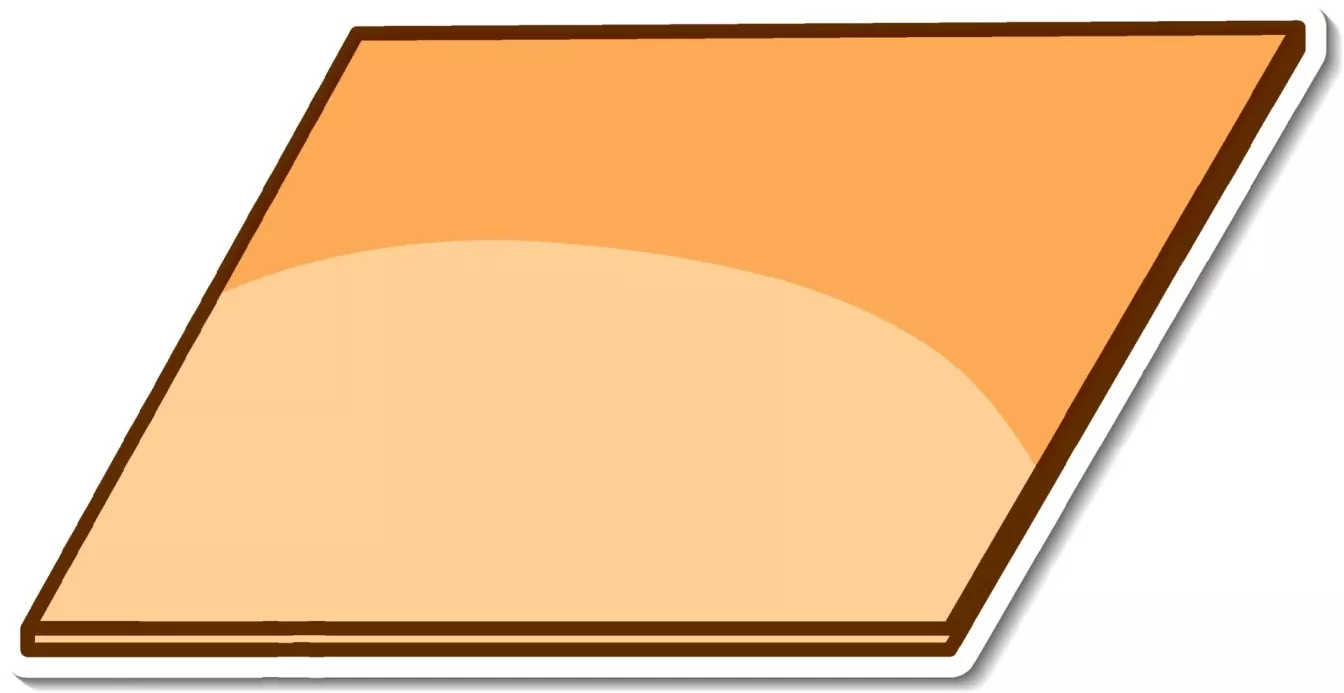Volume Of A Liquid
In this article, the objectives are:
- Calculate the volume of a liquid in a rectangular container
- Calculate the volume of liquid needed to fill a container to a certain height
Volume recap
- \( \text{Volume of a cube} = \text{length} \times \text{length} \times \text{length}\)
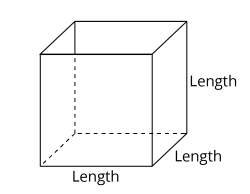
- \( \text{Volume of a cuboid} = \text{length} \times \text{breadth} \times \text{height}\)
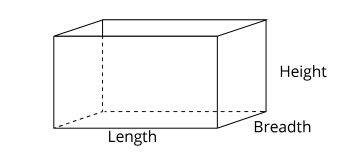
1. Calculate the volume of a liquid in a rectangular container
Question 1:
The diagram below shows a rectangular tank filled with some liquid.
Find the volume of the liquid in the tank.
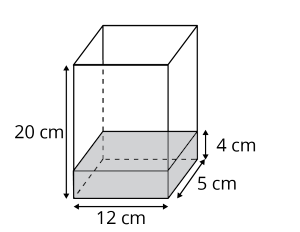
Solution:
Length of cuboid \(= \text{12 cm}\)
Breadth of cuboid \(= \text{5 cm}\)
Height of liquid in cuboid \(= \text{4 cm}\)
Volume of a liquid in cuboid
\(\begin{align*}&= \mathrm{length \times breadth \times height} \\[2ex] &= \mathrm{12 \;cm \times 5 \;cm \times 4 \;cm} \\[2ex] &= \text{240 cm}^3 \end{align*}\)
Answer:
\(\text{240 cm}^3\)
Question 2:
In the diagram below, find the volume of the liquid in the rectangular tank.
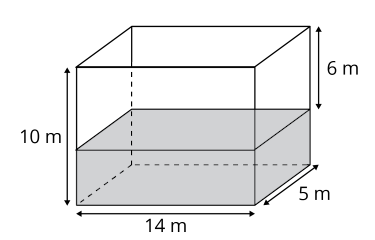
Solution:
Length of rectangular tank \(= \text{14 m}\)
Breadth of rectangular tank \(= \text{5 m}\)
Height of liquid in rectangular tank
\(\begin{align*} &= \text{10 m – 6 m} \\[2ex] &= \text{4 m} \end{align*}\)
Volume of liquid in tank
\(\begin{align*}&= \mathrm{length \times breadth \times height} \\[2ex] &= \mathrm{14 \;m \times 5 \;m \times 4 \;m} \\[2ex] &= \text{280 m}^3 \end{align*}\)
Answer:
\(\text{280 m}^3\)
Question 3:
Find the volume of the liquid in the rectangular tank. Express your answer in litres.
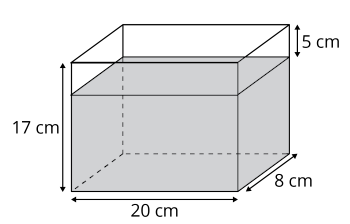
Solution:
Length of rectangular tank \(= \text{20 cm}\)
Breadth of rectangular tank \(= \text{8 cm}\)
Height of liquid in rectangular tank
\(\begin{align*} &= \text{17 cm – 5 cm} \\[2ex] &= \text{12 cm} \end{align*}\)
Volume of liquid in the tank
\(\begin{align*} &= \mathrm{length \times breadth \times height} \\[2ex] &= \mathrm{20 \;cm \times 8 \;cm \times 12 \;cm} \\[2ex] &= \mathrm{1920 \;cm}^3 \\[2ex] &= \mathrm{1.92 \;litres} \end{align*}\)
Answer:
\(\text{1.92 litres}\)
Question 4:
Chloe bought some apple juice and poured all of it into \(\displaystyle{2}\) rectangular containers. Container \(\displaystyle{\text{P}}\) measuring \(\displaystyle{\text{15 cm}}\) by \(\displaystyle{\text{8 cm}}\) by \(\displaystyle{\text{6 cm}}\) is \(\displaystyle{\frac{3}{4}}\) filled while Container \(\displaystyle{\text{Q}}\) measuring \(\displaystyle{\text{25 cm}}\) by \(\displaystyle{\text{18 cm}}\) by \(\displaystyle{\text{10 cm}}\) is \(\displaystyle{\frac{5}{6}}\) filled. What is the volume of apple juice that Chloe bought?
Solution:
Volume of apple juice in Container \(\displaystyle{\text{P}}\)
\(\begin{align*} &= \mathrm{\frac{3}{4}\times \text{length} \times \text{breadth} \times \text{height}} \\[2ex] &= \mathrm{\frac{3}{4}\times 15 \;cm \times 8 \;cm \times 6 \;cm} \\[2ex] &= \mathrm{540 \;cm}^3 \\ \end{align*}\)
Volume of apple juice in Container \(\displaystyle{\text{Q}}\)
\(\begin{align*} &= \mathrm{\frac{5}{6}\times \text{length} \times \text{breadth} \times \text{height}} \\[2ex] &= \mathrm{\frac{5}{6}\times 25 \;cm \times 18 \;cm \times 10 \;cm} \\[2ex] &= \mathrm{3750 \;cm}^3 \\ \end{align*}\)
Total volume of apple juice Chloe bought
\(=\) Volume of apple juice in Container \(\displaystyle{\text{P + }}\) Volume of apple juice in Container \(\displaystyle{\text{Q}}\)
\(\begin{align*} &= \mathrm{540 \;cm}^3 + \mathrm{3750 \;cm}^3 \\[2ex] &= \mathrm{4290 \;cm}^3 \end{align*}\)
Answer:
\(\mathrm{4290 \;cm}^3\)
Question 5:
A painter mixed some paint to paint a wall. He poured all the paint into two rectangular containers. Container \(\text{X}\) measuring \(\displaystyle{\text{55 cm}}\) by \(\displaystyle{\text{48 cm}}\) by \(\displaystyle{\text{30 cm}}\) was \(\displaystyle{\frac{5}{8}}\) filled while Container \(\text{Y}\) measuring \(\displaystyle{\text{47 cm}}\) by \(\displaystyle{\text{39 cm}}\) by \(\displaystyle{\text{30 cm}}\) was \(\displaystyle{\frac{10}{13}}\) filled. What was the volume of the paint that the painter mixed?
Solution:
Volume of paint in Container \(\text{X}\)
\(\begin{align*} &= \frac{5}{8}\times \text{length} \times \text{breadth} \times \text{height} \\[2ex] &= \frac{5}{8}\times 55 \text{ cm} \times 48 \text{ cm} \times 30 \text{ cm} \\[2ex] &= 49\,500 \text{ cm}^3 \\ \end{align*}\)
Volume of paint in Container \(\text{Y}\)
\(\begin{align*} &= \frac{10}{13}\times \text{length} \times \text{breadth} \times \text{height} \\[2ex] &= \frac{10}{13}\times 47 \text{ cm} \times 39 \text{ cm} \times 30 \text{ cm} \\[2ex] &= 42\,300 \text{ cm}^3 \\ \end{align*}\)
Total volume of paint mixed
\(=\) Volume of paint in Container \(\text{X}\) \(+\) Volume of paint in Container \(\text{Y}\)
\(\begin{align*} &= 49 \,500 \text{ cm}^3 + 42 \,300 \text{ cm}^3 \\[2ex] &= 91 \,800 \text{ cm}^3 \end{align*}\)
Answer:
\(91 \,800 \text{ cm}^3\)
2. Calculate the volume of liquid needed to fill a container to a certain height
Question 1:
A rectangular tank shown below was half–filled with water. Another \(10.05 \text{ litres}\) of water was then added to the tank. How much more water was needed to fill the tank to the brim? Give your answer in litres.
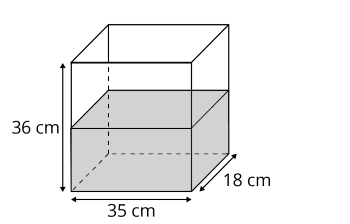
Solution:
\(1000 \text{ cm}^3 = 1 \mathrm{ \,\ell}\)
Volume of water in the tank
\(\begin{align*} &= \frac{1}{2} \times 35 \text{ cm} \times 18 \text{ cm} \times 36 \text{ cm} \\[2ex] &= 11 \;340 \text{ cm}^3 \\[2ex] &= 11.34 \;ℓ \end{align*}\)
Remaining volume left to fill the tank
\(\begin{align*} &= \frac{1}{2} \times 35 \text{ cm} \times 18 \text{ cm} \times 36 \text{ cm}\\[2ex] &= 11\,340 \text{ cm}^3\\[2ex] &= 11.34 \;ℓ \end{align*}\)
Volume of water added in the tank \(= 10.05 \;ℓ\)
Volume of water needed to fill till the brim
\(\begin{align*} &= 11.34 \;ℓ − 10.05 \;ℓ\\[2ex] &= 1.29 \;ℓ \end{align*}\)
Answer:
\(1.29 \;ℓ\)
Question 2:
Jenny filled \(\displaystyle{\frac {2}{3}}\) of a square–based container with a cocktail. The guests drank \(\text{2.5 litres}\) of cocktail. How much more cocktail must she add in order to fill the container to the brim? Give your answer in litres.

Solution:
\(1000 \text{ cm}^3 = 1 \;ℓ\)
Volume of cocktail
\(\begin{align*} &= \frac{1}{2} \times 11 \text{ cm} \times 11 \text{ cm} \times 45 \text{ cm} \\[2ex] &= 3630 \text{ cm}^3 \\[2ex] &= 3.63 \;ℓ \end{align*}\)
Volume of cocktail drank \(= 2.5 \;ℓ\)
Volume of cocktail left
\(\displaystyle{ = 3.63 \;ℓ - 2.5 \;ℓ \\[2ex] = 1.13 \;ℓ }\)
Volume of container
\(\begin{align} &= 11 \text{ cm} \times 11 \text{ cm} \times 45 \text{ cm} \\[2ex] &= 5445 \text{ cm}^3 \\[2ex] &= 5.445 \;ℓ \end{align}\)
Volume of cocktail needed to fill till the brim
\(\begin{align*} &= 5.445 \;ℓ - 1.13 \;ℓ \\[2ex] &= 4.315 \;ℓ \end{align*}\)
Answer:
\(4.315 \;ℓ\)
Question 3:
Karen filled \(\displaystyle{\frac {1}{3}}\) of rectangular Container \(\text{A}\) measuring \(\text{24 cm}\) by \(\text{18 cm}\) by \(\text{30 cm}\) with orange juice. Karen then added more orange juice such that half of Container \(\text{A}\) was filled with orange juice. How much more orange juice did Karen add to Container \(\text{A}\)?
Solution:
Volume of orange juice in the tank
\(\begin{align*} &= \frac{1}{3} \times 24 \text{ cm} \times 18 \text{ cm} \times 30 \text{ cm} \\[2ex] &= 4320 \text{ cm}^3 \end{align*}\)
Volume of \(\displaystyle{ \frac {1}{2}}\) of Container \(\text{A}\)
\(\begin{align*} &= \frac{1}{2} \times 24 \text{ cm} \times 18 \text{ cm} \times 30 \text{ cm} \\[2ex] &= 6480 \text{ cm}^3 \end{align*}\)
Volume of orange juice Karen added
\(\begin{align} &= 6480 \text{ cm}^3 - 4320 \text{ cm}^3 \\[2ex] &= 2160 \text{ cm}^3 \end{align}\)
Answer:
\(2160 \text{ cm}^3\)
OR
\(\displaystyle{\frac {1}{2}-\frac{1}{3} = \frac{1}{6}}\)
Volume of orange juice Karen added
\(\begin{align} \textstyle &= \frac{1}{6} \times 24 \text{ cm} \times 18 \text{ cm} \times 30 \text{ cm} \\[2ex] &= 2160 \text{ cm}^3 \\ \end{align}\)
Answer:
\(2160 \text{ cm}^3\)
Conclusion
In this article, we have learnt how to calculate the volume of liquids in a container as per the Primary 5 Maths level syllabus.
 SG
SG  VN
VN 

